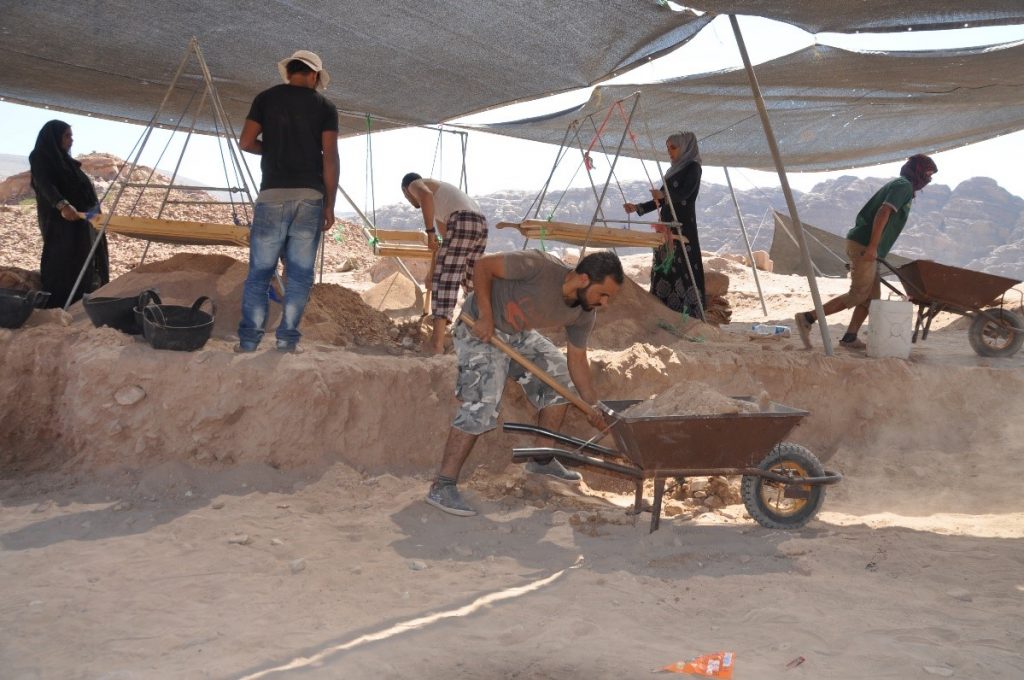This page was archived as of 2020/2021. For the latest information and news about the Temple of Winged Lions and Temple of Winged Lions Cultural Resource Management Initiative, please visit our new archaeological projects portal (acorjordan.org/archaeological-projects/).
The Temple of the Winged Lions Cultural Resource Management (TWLCRM) Initiative was launched in 2009 as a collaboration among ACOR, the Department of Antiquities of Jordan (DOA), and the Petra Archaeological Park (PAP), the local authority that administers and manages Petra.
The TWLCRM Initiative aims to stabilize, conserve, and present the temple and its precinct for future generations, while also rehabilitating the surrounding landscape.

In addition to conserving the exposed building remains to current international standards, the TWLCRM Initiative plans to restore five columns, along with their associated floral and winged-lion capitals, within the temple’s inner sanctuary, thereby allowing visitors to appreciate the monument’s original scale and grandeur. Furthermore, the TWLCRM Initiative is re-documenting each wall and feature within the temple, as well as all recovered artifacts and objects, through proper survey, measurement, photography, and drafting.
An intensive landscape rehabilitation program attempts to reverse the negative effects of early excavations of the American Expedition to Petra (AEP) in the 1980’s and 1990’s at the temple site on Petra’s landscape. This has meant, among other things, removing the obtrusive excavation dumps and rubble piles scattered across the site, consolidating the architectural stone fragments on site (lapadaria), as well as backfilling numerous excavation scars and trenches that were created during the aforementioned early excavations.

The soil cleared from the dumps, after it is sifted for pottery, coins, and other objects missed during the original excavation, is not simply being piled elsewhere, but rather is “recycled” for use in the project’s various backfilling and conservation efforts. The site’s rock piles are recycled in a similar fashion, as different stone types and sizes are sorted for use in backfilling and site presentation efforts. While the clearing and backfilling work proceeds, the TWLCRM is also conducting a multi-year vegetation study aimed at identifying and eventually reintroducing native species that will both stabilize the topsoil and rehabilitate the local environmental context.

Along the way, however, the TWLCRM Initiative realized that the long-term preservation of the site was not just a matter of conserving stones and clearing away rubble, but also ensuring that local communities—long marginalized by scholars and authorities alike—were invited and empowered to participate directly in the goals of the project. This realization resulted in an innovative and award-winning social engagement strategy that provided Petra’s local, mostly Bedouin communities with employment, training, and educational opportunities in site preservation and cultural resource management. In addition to providing much-needed income for one of the poorest communities in Jordan, the nearly 700 employment opportunities generated through the project as of 2015—the majority filled by women and youths—have encouraged local communities to become equal stakeholders in the site’s preservation and sustainability. What is more, by having a nearly continuous, year-round presence on site (instead of working in the field only in the summer, as is typical for most foreign projects in Jordan), the TWLCRM Initiative has developed a much stronger relationship with the community and this has allowed for greater investment in the people being trained. For its efforts, the TWLCRM Initiative earned the Archaeological Institute of America’s 2015 award for Best Practices in Site Preservation and, more importantly, now serves as a model for how other community-based aid and development projects related to archaeology, cultural heritage, and tourism should be structured and implemented in Jordan.[/vc_column_text]
The TWLCRM Initiative is grateful for the generous support of Royal Jordanian Airlines.

